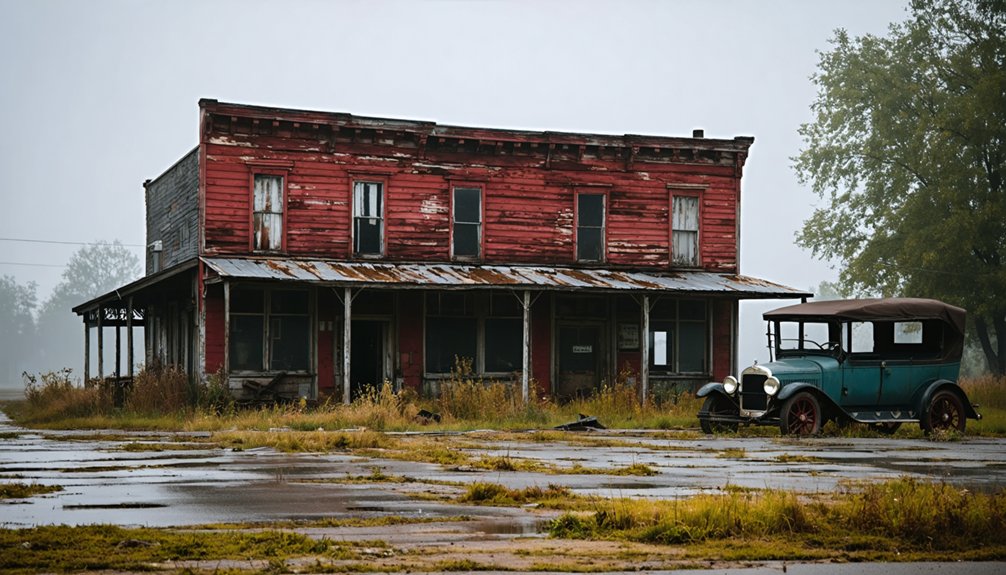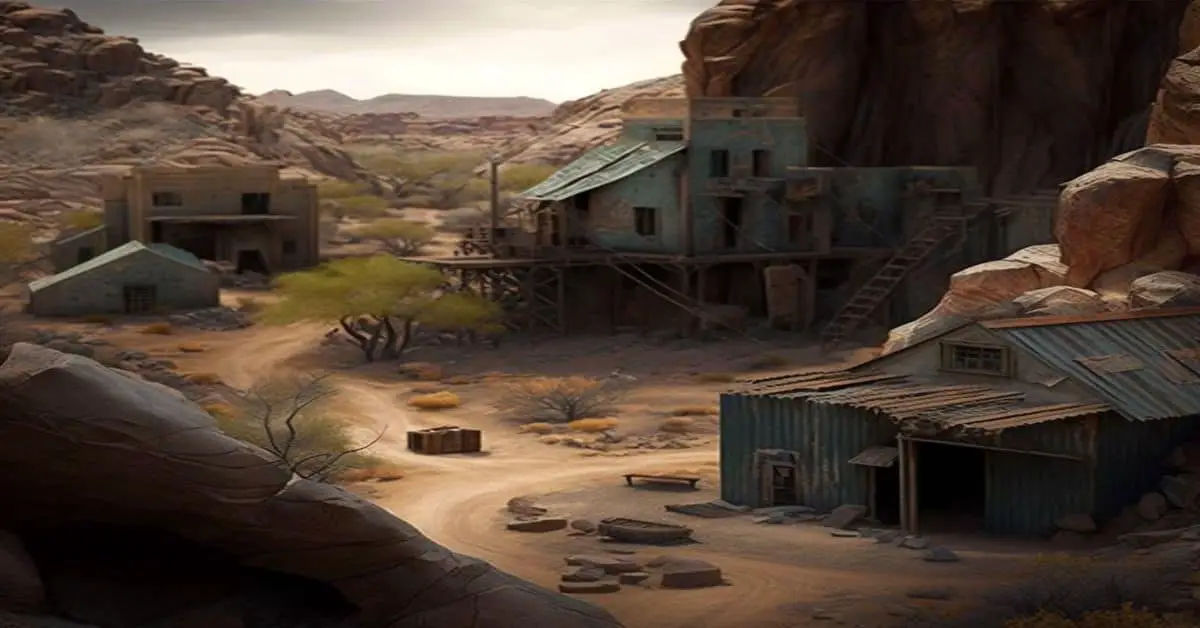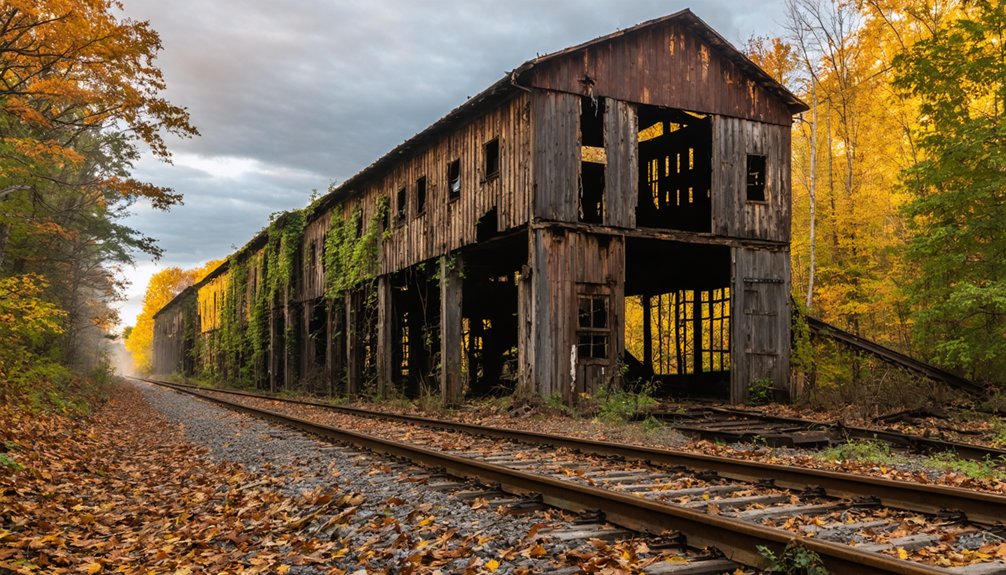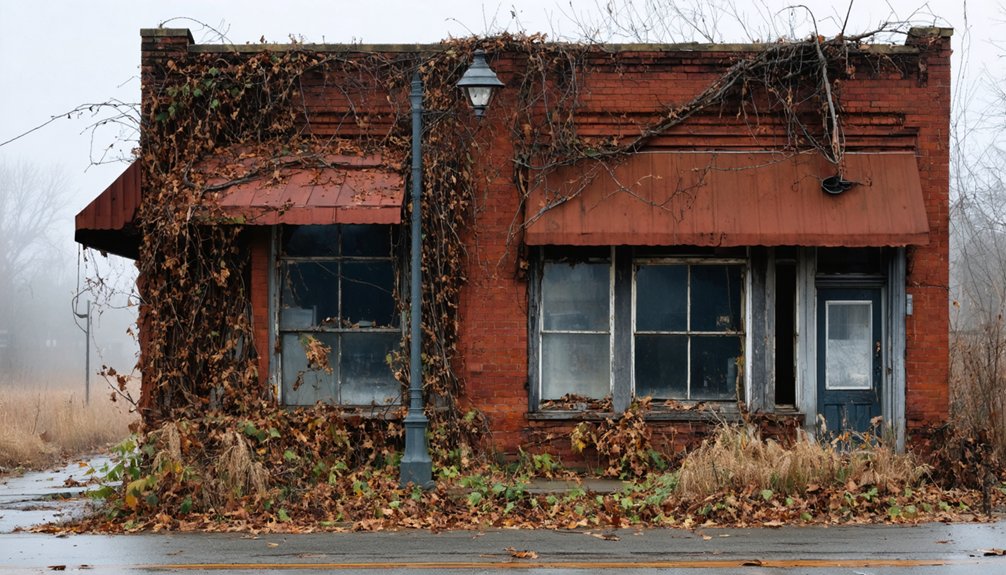You’ll discover Barbersville’s remnants in Jefferson County’s Shelby Township, where a bustling frontier town flourished from 1816 until the early 1900s. This close-knit farming community centered around a public square with 64 lots, featuring grocery stores, an essential post office, and churches that fostered social gatherings. While nature has reclaimed most traces of this ghost town, its rich history of Underground Railroad connections and pioneer spirit still echoes through time.
Key Takeaways
- Barbersville was established in 1816 in Jefferson County’s Shelby Township, Indiana, with an initial layout of 64 lots around a public square.
- The town’s population peaked at around 100 residents but declined significantly after the post office closed in 1906.
- Economic stagnation and lack of rail connections contributed to Barbersville’s abandonment, leaving only scattered farms and a small general store.
- Today, only faint building foundations remain of the original settlement, with nature having reclaimed most of the former town site.
- The Elizabethtown Cemetery serves as the main physical connection to Barbersville’s past, preserving the area’s historical legacy.
The Rise of a Frontier Settlement
As Indiana achieved statehood in 1816, the small frontier settlement of Barbersville took root in Jefferson County‘s Shelby Township, emerging from the earlier foundations of Edinburgh that had been platted just a year before.
Like other early Indiana communities, merchants relied on flatboat transportation to move goods along the waterways. You’d have found this ambitious community laid out with 64 lots surrounding a welcoming public square, marking the Barbersville origins as a place of promise and possibility.
The town’s pioneers carved out their existence along Main Street, Broadway, and Main Cross Street, facing the typical settlement challenges of frontier life. A hub of local commerce emerged when Timothy Barber became the settlement’s first postmaster and received licenses to sell foreign merchandise in 1829.
Early Commerce and Post Office Establishment
The heartbeat of Barbersville’s early days centered around its post office, established in 1826 under the careful watch of Timothy Barber, the town’s first postmaster.
You’d find Barber not just handling mail, but also selling foreign goods like sugar and coffee, having secured his merchant’s license from Jefferson County Commissioners in 1829.
Through decades of change, the post office operations reflected the ebb and flow of frontier life. Like the early mail routes of Indiana, riders on horseback carried correspondence through challenging terrain and treacherous waters.
You’ll notice patterns of resilience as the office closed in 1838, shifted to Buchanan’s Station, then triumphantly returned in 1848.
Early commerce flourished along Main Street, Broadway, and Main Cross Street, where settlers gathered to trade and collect their mail. The town grew steadily to include fifteen platted lots by December 1848.
Community Life in 19th Century Barbersville
If you’d visited Barbersville in the late 1800s, you’d have found a tight-knit farming community where neighbors gathered regularly at William H. Kramer’s grocery store or the bustling post office to share news and trade goods.
The town’s social fabric was woven through the weekly rhythm of commerce at the corn mill, cattle auctions, and the two local grocers that served as informal meeting spots for residents.
Life in this rural hamlet centered around agricultural routines and local business, with farmers working their grain fields and orchards while relying on each other for support and fellowship.
Daily Life and Commerce
Life in nineteenth-century Barbersville revolved around a close-knit farming community where grain, cattle, and fruit production shaped daily routines.
You’d find yourself rising early to tend to crops and livestock, joining neighbors at the local corn mill that operated twice weekly. Farming practices ranged from subsistence agriculture to commercial ventures, with families working together on fieldwork, hay stacking, and fence repairs.
Local trades flourished around the town’s agricultural heart. You could stop by one of two grocery stores, or visit the general store that doubled as the post office for essentials like sugar and coffee.
The farm implements store and fertilizer business supported your farming needs, while cattle auctions provided opportunities to trade livestock with fellow community members.
Church and Social Gatherings
Beyond the fields and stores, spiritual life and social bonds found their heart in Barbersville’s church community. You’d find the town’s soul in the simple wooden structure that served as both sanctuary and gathering place, where Presbyterian, Methodist, or Disciples of Christ congregants would meet each Sunday. Like many churches during the Second Great Awakening, the local congregation participated in the broader religious revival sweeping across America.
The church wasn’t just for worship – it’s where you’d join your neighbors for vibrant ice cream socials, quilting bees, and seasonal celebrations that knit the community together.
During the height of the abolitionist movement, these sacred walls echoed with passionate discussions of freedom and moral responsibility. The church gatherings strengthened community cohesion through Sunday schools, revival meetings, and holiday festivities, making it impossible to separate Barbersville’s spiritual life from its social fabric.
Underground Railroad Activities
While concrete records remain elusive, Barbersville’s role in the Underground Railroad reflects the quiet courage of a community positioned along southeastern Indiana’s network of freedom routes.
You’d find the town strategically located near established abolitionist networks stretching from Madison and Newport, where brave conductors guided fugitive journeys northward toward Michigan.
Like many southeastern Indiana communities, Barbersville’s residents likely played their part in this dangerous yet crucial work. The town’s operations became even more secretive after federal laws of 1850 increased risks for those helping escaped slaves.
Local Quaker families might’ve opened their homes as safe houses, while physicians and teamsters provided essential support. Enclosed buggies driven by local doctors became a discreet method of transporting freedom seekers to safety.
Though time has obscured many details, Barbersville’s location along known escape corridors suggests its people shared in the region’s commitment to freedom, joining countless small towns whose everyday citizens risked everything to help others reach liberty.
Underground Railroad Connections
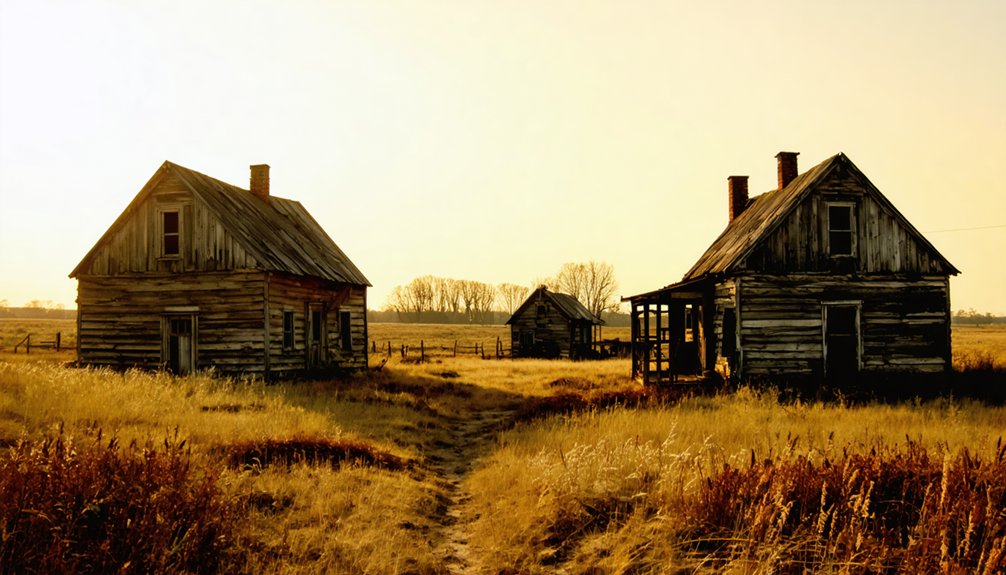
While you’ll find few concrete records of Barbersville’s Underground Railroad activities, local historians believe several homes in the area served as safe houses for freedom seekers moving northward through Jefferson County.
The peak population reached 100 during the town’s most active period in the Underground Railroad network. You can trace the likely path these brave souls took as they made their way from the Ohio River through Barbersville’s wooded areas, often guided by Quaker families who settled in the region.
The town’s strategic location between Madison’s established routes and the central Indiana networks suggests Barbersville played a quiet but important role in helping enslaved people reach freedom. One such freedom seeker, William Bush, paid $175 to escape on a riverboat to Cincinnati before eventually finding safety in Fountain City.
Local Abolitionist Safe Houses
Although local folklore speaks of Barbersville’s involvement in the Underground Railroad, historians haven’t uncovered concrete evidence linking the town to this critical network of safe houses and secret routes.
Unlike verified abolitionist networks in nearby Indiana communities, where hidden rooms and secret passages still stand as proof of their brave operators, Barbersville’s role remains shrouded in mystery.
You won’t find Barbersville’s safe house operations documented in major historical registers or primary sources that detail the Underground Railroad’s path through Indiana.
While communities like Newport and Crawfordsville have well-documented histories of concealing freedom seekers in false-bottom wagons and hidden compartments, Barbersville’s stories remain purely anecdotal.
Only further archaeological research and oral history collection might reveal the truth behind the town’s rumored contribution to this noble cause.
Underground Routes Through Jefferson
Despite Barbersville’s uncertain Underground Railroad connections, Jefferson County itself stands as a tribute to the courage and determination of freedom seekers and their allies.
You’ll find that escape routes through the county’s hilly terrain, particularly around Eagle Hollow and Ryker’s Ridge, provided natural cover for those seeking liberty. The Ohio River marked the essential starting point where fugitive networks began their northward journey through Indiana.
Along these paths, you’d have encountered a remarkable web of cooperation between Black leaders like George DeBaptiste and Chapman Harris, working alongside white abolitionists. The historic Lancaster settlement north played a vital role in supporting freedom seekers through its strong anti-slavery stance.
They’d established intricate systems using homes, farms, and churches as safe havens. The Neil’s Creek Anti-Slavery Society and local faith groups strengthened these networks, while places like the Lyman-Hoyt House became critical waypoints on the road to freedom.
The Path to Abandonment
As the nineteenth century drew to a close, Barbersville’s modest population of around 100 residents began dwindling steadily, their departure shaped by forces both within and beyond the town’s borders.
You’d have witnessed the town’s economic stagnation firsthand – a small general store and scattered farms weren’t enough to sustain a thriving community. When the post office closed in 1906, transferring its services to Canaan, the population decline accelerated.
Without rail connections or major roads, you couldn’t have built a prosperous future here. The rise of automobiles made it easier to seek opportunities elsewhere, while agricultural mechanization reduced the need for small farming communities.
One by one, your neighbors left until William Buchanan owned most of the land, and the last remnants of town life faded into memory.
What Remains Today
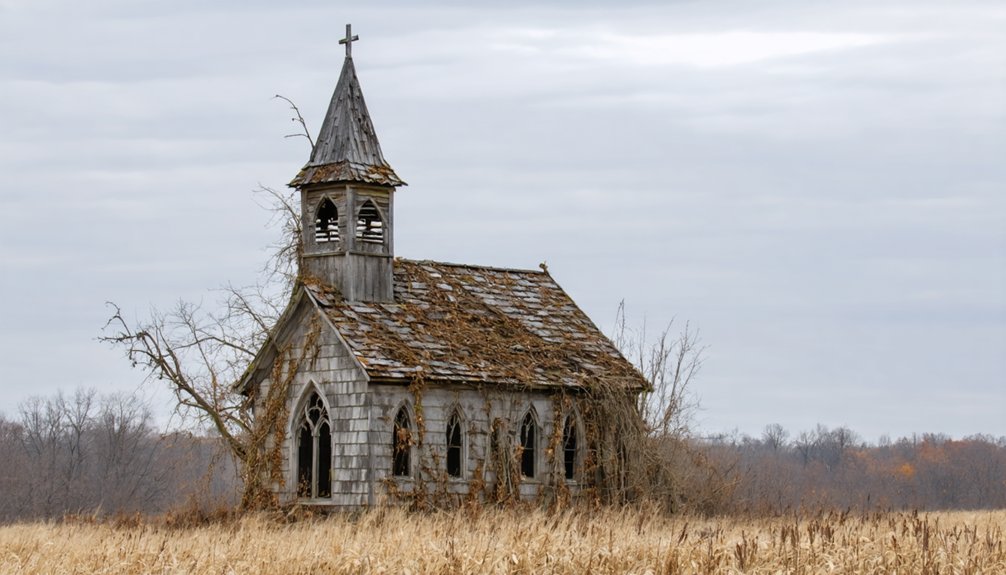
Today, you’ll find little evidence that Barbersville ever existed beyond a simple town sign marking its former location.
Nature has reclaimed what was once a bustling community, with fields and rural landscapes now dominating the area where homes and businesses once stood. The ghost town remnants are minimal – just faint traces of building foundations that have nearly vanished into the earth.
While local folklore keeps Barbersville’s memory alive, there aren’t any preserved historic structures or archaeological findings to explore.
The closest physical connection to the past is the Elizabethtown Cemetery, which lies outside Barbersville’s original boundaries.
Even the old transportation routes that once served the town have disappeared, leaving you with only imagination to picture the community that once called this quiet countryside home.
Historical Impact on Jefferson County
Though Barbersville itself faded into history, its influence on Jefferson County’s development can’t be understated. The town’s historical significance as part of the Underground Railroad network exemplifies the region’s strong anti-slavery stance, even if detailed records remain elusive.
You’ll find its community legacy most evident in its role as an early communication hub, with its 1826 post office serving as a crucial link for the area’s residents.
The town’s evolution mirrors broader changes that shaped Jefferson County’s rural landscape. While you won’t find physical traces of Barbersville today, its story reveals how small agricultural communities once formed the backbone of the county’s social fabric, connecting isolated farmers through commerce and communication until improved transportation transformed rural life forever.
Frequently Asked Questions
Were Any Civil War Soldiers or Veterans Known to Live in Barbersville?
While you’ll find Civil War veteran stories throughout Starke County’s records, there’s no definitive evidence of soldiers living specifically in Barbersville, though some likely settled in the surrounding rural community.
What Natural Disasters or Epidemics, if Any, Affected Barbersville’s Population?
You won’t find any Netflix documentaries about flood impacts or disease outbreaks here – historical records don’t show any natural disasters or epidemics that specifically affected this freedom-loving rural community’s population decline.
Did Native American Tribes Have Settlements Near Barbersville Before Its Founding?
You’ll find rich tribal history in this area, where Delaware Indians established thriving settlements near State Road 37 and along Sugar Creek, following traditional settlement patterns of riverside communities.
What Was the Average Property Value of Lots in Barbersville?
You’d be surprised, but there’s no conclusive property appraisal data for the lots. While land prices in similar Indiana ghost towns ranged from $50-1,600, Barbersville’s specific values remain a mystery.
Were There Any Documented Murders or Significant Crimes in Barbersville?
You won’t find any documented murders or significant crimes in the records. Despite searching through unsolved cases and crime history, there’s no evidence of serious criminal activity in your community’s past.
References
- https://www.youtube.com/watch?v=45D4dbASJyE
- http://justahoosiergirl.blogspot.com/2014/09/the-little-known-ghost-town-of.html
- https://www.youtube.com/watch?v=qlsm3XC-R6I
- https://www.onlyinyourstate.com/trip-ideas/indiana/ghost-town-road-trip-indiana
- https://en.wikipedia.org/wiki/Barbersville
- https://en.wikipedia.org/wiki/List_of_ghost_towns_in_Indiana
- https://www.historymuseumsb.org/pioneer-settlement-in-indiana-1790-1849/
- https://indianahistory.org/research/research-materials/early-black-settlements/early-black-settlements-by-county/
- https://www.pioneersettlement.org/history
- https://www.onlyinyourstate.com/trip-ideas/indiana/abandoned-town-in-indiana
